Leonardo da Vinci revisited: was he an environmentalist ahead of his time?
- Written by Susan Broomhall, Professor of History, University of Western Australia
On the 500th anniversary of his death, this series brings together scholars from different disciplines to re-examine the work, legacy and myth of Leonardo da Vinci.
Leonardo’s notebooks are filled with illustrations of nature, both plants and animals, their interactions with humans and in local ecosystems. Did his deep engagement with the natural world make him an environmentalist ahead of his time?
Leonardo was a child of the Tuscan countryside, raised in the tiny village of Anchiano, although he spent most of his adult life at the courts of dukes, kings and princes.
Some of his work for these patrons involved planning interventions into nature, most often managing waterways, but his sketches suggest his attention roamed further than the projects he was commissioned to undertake.
He spent time with friends in a villa outside of Milan observing the country nearby and sketching plans for gardens there, and ended his life on a little country estate that was then on the outskirts of Amboise in France.
One of his first biographers, Giorgio Vasari, tells us that Leonardo
delighted much in horses and also in all other animals, and often when passing by the places where they sold birds he would take them out of their cages, and paying the price that was asked for them, would let them fly away into the air, restoring to them their lost liberty.
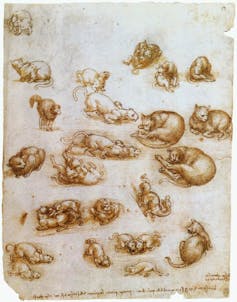 Leonardo da Vinci, Study sheet with cats, dragon and other animals, c. 1513.
Wikiart.org
Leonardo da Vinci, Study sheet with cats, dragon and other animals, c. 1513.
Wikiart.org
Leonardo was also reportedly a vegetarian. This supposition comes from the explorer Andrea Corsali’s description of the non-meat-eating Gujarati people (from modern India) as like “our Leonardo da Vinci”.
The many notebooks and loose sheets Leonardo filled with jottings and illustrations across his lifetime reveal his close observation of nature — from cats and crabs to flowers and copses of trees - and the spirit of enquiry from which he drew many lessons.
One jotting simply states: “Ask the wife of Biagio Crivelli how the capon nurtures and hatches the eggs of the hen”.
His understandings of the habits of animals informed a series of fables and proverbs bearing witness to various emotional traits he attributed to them: gratitude, rage, cruelty and generosity among them. He suggested, for instance, that “we see the most striking example of humility” in the lamb.
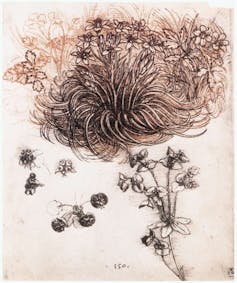 Star of Bethlehem, Ornithogalum umbellatum
Wikiart.org
Star of Bethlehem, Ornithogalum umbellatum
Wikiart.org
The random cruelty of nature
But Leonardo was also struck by the violence of natural processes. Nature appears to have been “rather a cruel stepmother”, he wrote. “Why did nature not ordain that one animal should not live by the death of another?”
He reflected on the random cruelty of nature in a series of riddles, created across his notebooks. For instance, in the entry on walnut trees, he writes in emotional terms of the violence wrought upon these trees as humans enjoyed their seeds: “beaten, and their offspring taken and flayed or peeled, and their bones broken or crushed.”
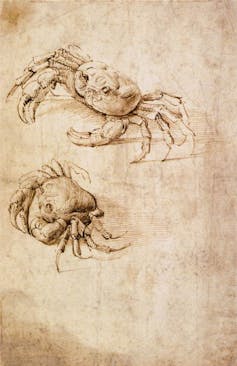 Leonardo da Vinci, Studies of crabs, c. late 15th century.
Wikiart.org
Leonardo da Vinci, Studies of crabs, c. late 15th century.
Wikiart.org
Still, Leonardo does not seem to have been particularly concerned about the role of humans in enacting violence against other species. His own quest for knowledge and artistic creativity demanded it.
Vasari tells a story of the young Leonardo seeking to depict a frightening creature on a shield he had “brought for this purpose to his room, which no one entered but himself, lizards, grasshoppers, serpents, butterflies, locusts, bats, and other strange animals of the kind …” “The smell in the room of these dead animals was very bad, though Leonardo did not feel it from the love he bore to art.”
Vasari talks of how Leonardo “suffered much in doing it” - but not as much as the other species whose lives were sacrificed for his art.
In other tales, Vasari tells us how Leonardo, while he was working for Giuliano de’ Medici in Rome, discovered an unusual lizard and promptly
made some wings of the scales of other lizards and fastened them on its back with a mixture of quicksilver, so that they trembled when it walked; and having made for it eyes, horns, and a beard, he tamed it and kept it in a box.
For Vasari, these stories show Leonardo’s “marvelous and divine” mind, but they could also be interpreted as showing the instrumental way in which Leonardo thought about nature, as a resource to expand human knowledge and control the environment.
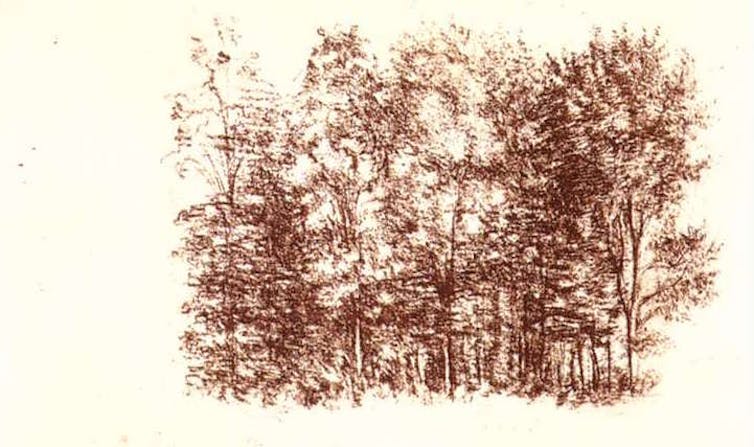 Leonardo da Vinci, Birch copse, c. 1500.
Wikiart.org
Leonardo da Vinci, Birch copse, c. 1500.
Wikiart.org
Leonardo’s nature
His contemporaries clearly thought there was something different about Leonardo and his interest in nature. Does this make him a kind of pre-modern environmentalist?
Western environmentalism (and before it, preservationism) is often understood to have become possible when nature had been subdued by technology. With urbanisation and development of a middle class, more people could feel sentimental about nature.
Although he was raised in the countryside, Leonardo spent most of his everyday adult life in major European towns in the company of princes and kings. He was no longer concerned directly with the need to cut down wood for warmth or kill animals for food. We could say, then, that he could afford to be more sentimental about nature.
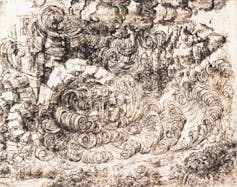 Leonardo da Vinci, Natural disaster, c. 1517.
Wikiart.org
Leonardo da Vinci, Natural disaster, c. 1517.
Wikiart.org
Certainly his exquisite drawings suggest a particular depth of feeling, attunement and sensitivity to the natural world. And yet it seems that preservation of nature was not on Leonardo’s mind.
He had not witnessed the speed and scale of devastation of the natural world wrought by humanity with the onset of industrialisation. Instead, he understood destruction as part of the cycle of nature. If, as he wrote, nature “seeks to lose its life, desiring only continual reproduction”, there was nothing to be protected, for annihilation and creation went hand in hand.
Authors: Susan Broomhall, Professor of History, University of Western Australia





